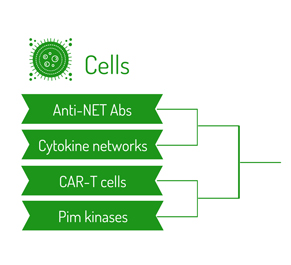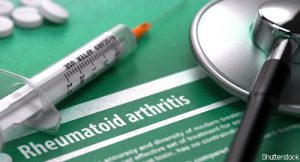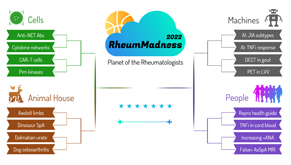 Editor’s note: RheumMadness is the place for everyone crazy about rheumatology to connect, collaborate, compete and learn together. During RheumMadness, rheumatology concepts represent teams that compete against each other in a tournament, much like basketball teams do in the NCAA’s March Madness tournament. In a series for The Rheumatologist, readers will get a chance to read the scouting reports for each concept team. These reports are written by rheumatology fellows from 13 programs throughout the U.S.
Editor’s note: RheumMadness is the place for everyone crazy about rheumatology to connect, collaborate, compete and learn together. During RheumMadness, rheumatology concepts represent teams that compete against each other in a tournament, much like basketball teams do in the NCAA’s March Madness tournament. In a series for The Rheumatologist, readers will get a chance to read the scouting reports for each concept team. These reports are written by rheumatology fellows from 13 programs throughout the U.S.
Don’t forget to submit your RheumMadness 2022 bracket by March 25. The more your picks match those of our Blue Ribbon Panel of rheumatologists, the more points you get. Learn more about the panel and how the brackets work online.
Connect with RheumMadness by subscribing to the podcast and joining the conversation on Twitter, #RheumMadness. Learn more on the RheumMadness website.
Region: Cells Team: Pim Kinases
Michael Jordan didn’t just dominate the basketball world of the 1990s—he also tried his hand at baseball. In this team’s base article by Maney et al., Pim kinases lace up their Air Jordans and try to “be like Mike,” showing promise as the next great two-sport athlete in both oncology and rheumatology.1
There are three Pim kinase subtypes: Pim-1, Pim-2 and Pim-3. These kinases are considered oncoproteins because, when overactive, they increase cell survival, proliferation and migration, and their overexpression is associated with worse clinical outcomes in cancer. Thus, oncologists are already investigating the anti-tumor effects of Pim kinase inhibitors. However, cancer cells are not the only cells that proliferate out of control due to Pim kinases. It turns out Pim kinases are downstream of the interleukin (IL) 6/STAT3 inflammatory pathway, and a growing body of literature shows Pim kinases influence T cell differentiation and synovial fibroblast function in rheumatoid arthritis (RA).1,2
 The base article for this team demonstrates how Pim kinases contribute to RA pathogenesis, explores the therapeutic potential of Pim kinase inhibition in RA and tantalizes readers with a possible precision medicine approach to identify patients who may benefit from this therapy.1 Using the Newcastle Early Arthritis Cohort (NEAC), the authors found increased Pim-1 expression in CD4+ T cells and other T cells in patients with early RA compared with patients with non-RA rheumatic diseases (e.g., psoriatic arthritis, other SpA, SLE and gout). This finding wasn’t just in peripheral blood; it also occurred in synovial biopsies of patients with early RA.
The base article for this team demonstrates how Pim kinases contribute to RA pathogenesis, explores the therapeutic potential of Pim kinase inhibition in RA and tantalizes readers with a possible precision medicine approach to identify patients who may benefit from this therapy.1 Using the Newcastle Early Arthritis Cohort (NEAC), the authors found increased Pim-1 expression in CD4+ T cells and other T cells in patients with early RA compared with patients with non-RA rheumatic diseases (e.g., psoriatic arthritis, other SpA, SLE and gout). This finding wasn’t just in peripheral blood; it also occurred in synovial biopsies of patients with early RA.
Next, the researchers demonstrated that exposing the T cells of patients with early RA to Pim kinase inhibitors reduced T cell activation. Pim kinase inhibitors were also effective in a mouse model of RA. Importantly, it didn’t matter if a specific Pim-1 inhibitor or a non-specific, pan-Pim inhibitor was used—both approaches seemed effective. However, pan-Pim inhibition led to increased regulatory T cells. This finding is significant, because previous studies favored Pim-1 as the main driver of cytokine-induced proliferation and inflammation.2
Finally, the researchers demonstrated that a novel flow cytometry approach, PrimeFlow, may identify Pim kinase overexpression in CD4+ T cells just as well as the more complicated gold standard of PCR of purified CD4+ T cells. This method may accelerate Pim kinase research and open the door for precision medicine with Pim kinase inhibitors.
Implications
We need more oral targeted therapies for patients with refractory RA, and Pim kinase inhibition is a promising candidate to achieve that goal. Although IL-6 and Janus kinase (JAK) inhibitors target the same inflammatory pathway, Pim kinases act further downstream. Thus, their inhibition may avoid some of the off-target effects of currently available therapies, such as the increased cardiac, thromboembolic and malignancy risk with tofacitinib suggested by the ORAL Surveillance study.3 At the very least, Pim kinase inhibitors do not interfere with markers of the acute phase response, such as C-reactive protein (CRP).1
Additionally, although it remains to be seen if elevated Pim kinase expression influences the therapeutic efficacy of Pim kinase inhibitors in RA, it’s exciting to think of the possibility of using a blood test to identify patients who may benefit from the flow cytometry techniques detailed in this study.1
This type of precision medicine would certainly be easier than the synovial biopsy strategy used in the R4RA study highlighted in last year’s RheumMadness tournament, and much easier than the machine learning strategy to predict tumor necrosis factor inhibitor (TNFi) response in the Machines Region of this year’s tournament.4,5
Chances in the Tournament
We think Pim Kinase is a heavy favorite to win its first-round matchup with CAR-T cells. Although Pim kinase inhibitors are a newcomer to rheumatology and still early in their development, CAR-T cell therapy is highly labor intensive compared with the promise of oral Pim kinase inhibitors. If the Blue Ribbon Panel recognizes Pim Kinases’ amazing scientific basis and therapeutic potential, this team may make it all the way to the championship. If they do, we hope they face Artificial Intelligence and TNFi Response from the Machines Region because both teams highlight the potential for precision medicine to optimize RA treatment.
Last year’s RheumMadness winner, avacopan, was approved by the U.S. Food & Drug Administration just a few months after the tournament ended. Pim Kinases could certainly win this year’s tournament, but fans may have to wait a bit longer for FDA approval.
Michael Macklin, MD, PharmD, is an internal medicine resident at the University of Pittsburgh Medical Center.
Ben Kellogg, MD, is an internal medicine resident at Duke University School of Medicine, Durham, N.C.
Lauren He, MD, is an internal medicine resident at the University of Chicago School of Medicine.
David Leverenz, MD, is an assistant professor of medicine in the Division of Rheumatology and Immunology at Duke University Medical School, Durham, N.C.
References
- Maney NJ, Lemos H, Barron‐Millar B, et al. PIM kinases as therapeutic targets in early rheumatoid arthritis. Arthritis Rheumatol. 2021 Oct;73(10):1820–1830.
- Ha Y, Choi YS, Han DW et al. PIM-1kinase is a novel regulator of proinflammatory cytoikine-mediated responses in rheumatoid arthritis fibroblast-like synoviocytes. Rheumatology (Oxford). 2019 Jan 1;58(1):154–164.
- Ytterberg S, Bhatt D, Mikuls T, et al. Safety and efficacy of tofacitinib vs. TNF inhibitors in RA patients aged 50 years or older with one or more cardiovascular risks: Results from a phase 3b/4 randomized safety trial [abstract 0831]. Arthritis Rheumatol. 2021 Oct;73 (suppl 10).
- Humby F, Durez P, Buch MH, et al. Rituximab versus tocilizumab in anti-TNF inadequate responder patients with rheumatoid arthritis (R4RA): 16-week outcomes of a stratified, biopsy-driven, multicentre, open-label, phase 4 randomised controlled trial. Lancet. 2021 Jan 23;397(10271):305–317.
- Vanderbilt University Medical Center Rheumatology Fellowship. Synovial B cells and therapy response (R4RA) scouting report. 2021 Mar 15.
 Experience All of RheumMadness
Experience All of RheumMadness
During RheumMadness, rheumatology concepts represent teams that compete against each other in a tournament, much like basketball teams do in the NCAA’s March Madness tournament. In a series for The Rheumatologist, readers will get a chance to read the scouting reports. Check out the reports from each region:
Region: Cells
Region: Animal House
Region: Machines
Region: People
• False Positive MRI in Axial SpA
Don’t forget to submit your RheumMadness 2022 bracket by March 25. The winner of each match-up is decided by a seven-member Blue Ribbon Panel of rheumatologists. The panel will vote based on which topic they think is most important to patients, providers and researchers—both now and in the future. The more your picks match those of the panel, the more points you get. The tournament results will be released in four rounds from March 26–April 4. Prizes will be given to participants with the top scores in the following categories: 1) attending/APP, 2) fellow and 3) resident/medical student. The prize is a custom RheumMadness coffee mug and a lifetime of bragging rights.
Connect with RheumMadness by subscribing to the podcast and joining the conversation on Twitter, #RheumMadness. Learn on the RheumMadness website.



